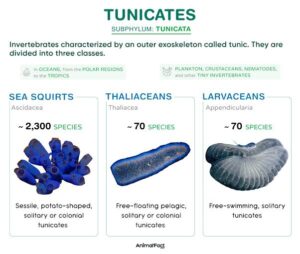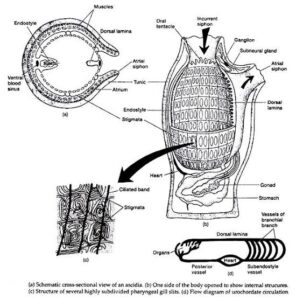Back to: ZOOLOGY 300 Level
WELCOME TO CLASS!
You’re most welcome, brilliant scholar! I’m super proud of your commitment to learning—it shows you’re serious about becoming a Zoology expert. Today, we’re focusing on two simple but very important chordates: tunicates and lancelets. They may not look like much at first, but trust me, these creatures hold powerful clues to understanding the backbone of all vertebrate life—including yours!
Tunicates And Lancelets: Structure, Feeding, Life History
Structure
Let’s begin with tunicates. These are marine animals found mostly attached to rocks or other surfaces under the sea. The name “tunicate” comes from their outer covering, called a tunic—a tough, jelly-like layer that protects their body. Adult tunicates look like little sacs, and you might easily mistake them for sea plants.

Now, onto lancelets—also known as amphioxus. These are small, fish-like animals that live in sandy areas of shallow seas. Unlike tunicates, lancelets keep their chordate features—like the notochord, dorsal nerve cord, and gill slits—throughout life. Their bodies are laterally flattened (like a blade of grass) and semi-transparent.
Feeding
Tunicates are filter feeders. Water enters through an opening called the incurrent siphon, flows through a mucous-covered pharynx where food particles are trapped, and exits through the excurrent siphon. Imagine pouring pap through a sieve—that’s how they trap their food!
Lancelets also feed by filtering. They bury their bodies in the sand with only the mouth sticking out. Water flows in, food particles are trapped by mucus, and passed to the gut for digestion. Their feeding method is simple but very efficient—like a constant, underwater buffet!
Life History
This is where tunicates surprise many students. As larvae, they have all the major chordate features—notochord, dorsal nerve cord, and tail. They swim around actively like tiny tadpoles. But once they settle on a surface, they go through metamorphosis and lose most of these features. Adults become stationary and sac-like, keeping only the pharyngeal slits. It’s like a lively teenager becoming a quiet adult who just stays in one place!

Lancelets, on the other hand, don’t change much as they grow. From larva to adult, they maintain all their chordate characteristics. This makes them an excellent model for studying what the earliest chordates might have looked like.
Summary
- Tunicates and lancelets are simple chordates found in marine environments.
- Tunicates have a tough outer tunic and lose many chordate features as adults.
- Lancelets keep all chordate traits throughout life.
- Both are filter feeders but differ in structure and mobility.
- Tunicates undergo dramatic metamorphosis; lancelets develop more steadily.
Evaluation
- What is the main difference in the adult structure of tunicates and lancelets?
- How do tunicates and lancelets feed?
- What chordate features do tunicate larvae have that adults lose?
- Why are lancelets considered important in evolutionary biology?
You’re really growing into a knowledgeable and confident learner. Keep asking questions, keep pushing forward, and remember—Afrilearn is with you every step of the way. I can’t wait to see what you’ll achieve next!
